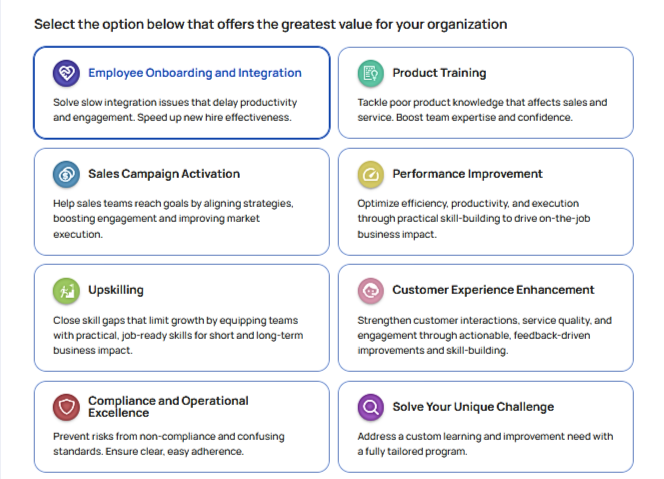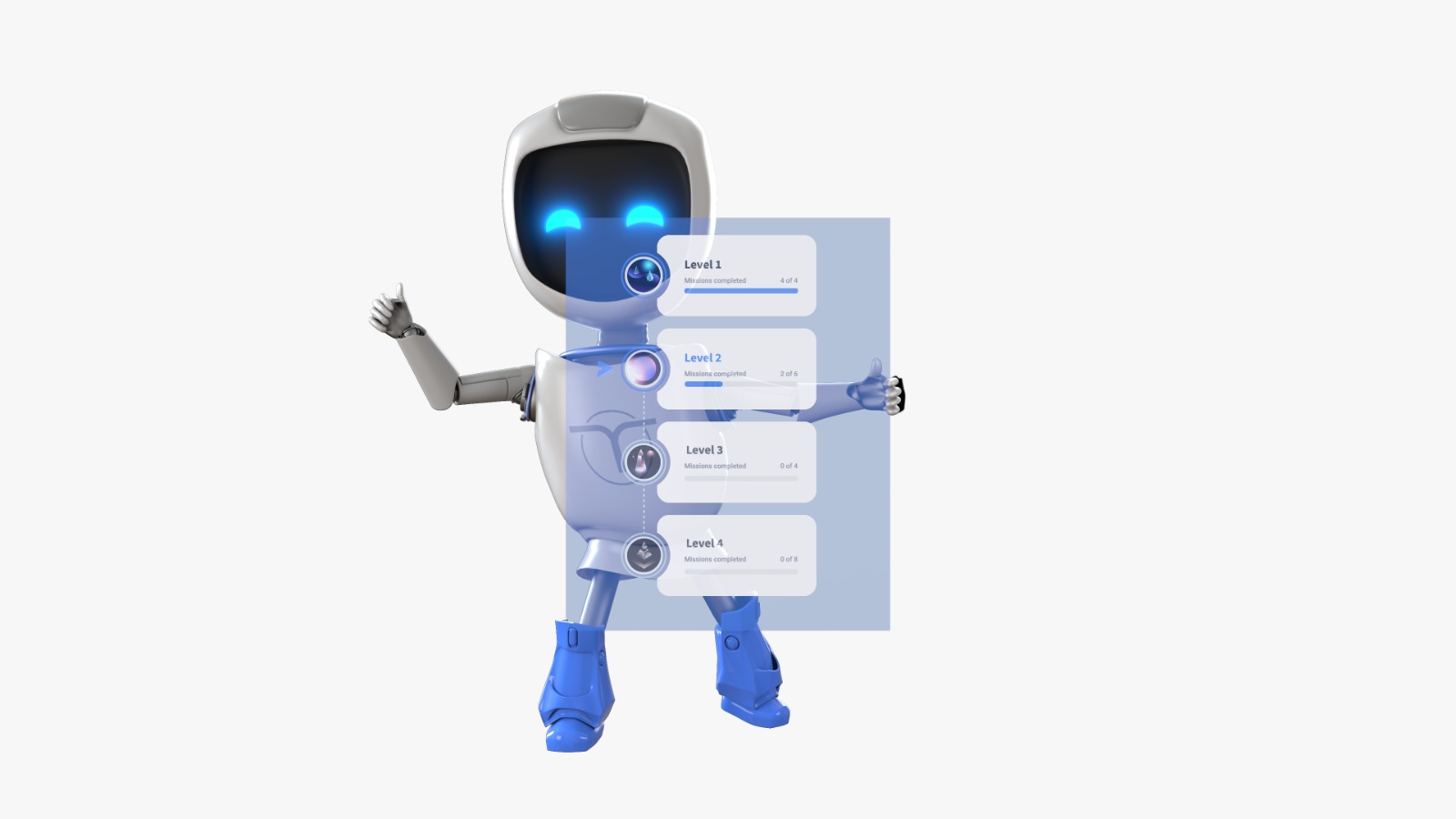Is your business still relying on outdated training methods? If so, you’re risking more than just inefficient learning—you’re also falling behind your competitors. According to Trainingmag, corporate training modernization improved in 2024, with companies investing almost $12.4 billion in outside training products and services, including online learning tools that incorporate gamification, microlearning, and simulations, among others. Microlearning examples, such as interactive quizzes and short video tutorials, are helping businesses create engaging learning experiences that employees can easily absorb and apply.
As businesses increasingly acknowledge that effective training is essential for employee growth and business success, they are also realizing the necessity of modernizing their learning and development (L&D) strategies. This need for transformation is undeniable—and one of the most effective, scalable solutions is microlearning.
This article explores what microlearning is, its benefits, key features, how it applies across industries, and some microlearning examples your business can incorporate for more modern training.
The High Cost of Ineffective Training
Before we explore the benefits of modern training, let’s examine the risks of neglecting it. Poor employee training doesn’t just waste time—it can significantly damage your business’s bottom line. According to the Association for Talent Development, organizations with weak L&D programs experience a 218% lower income per employee and 31% lower employee satisfaction.
But the financial toll doesn’t end there. If your training isn’t up to par, you risk errors, low productivity, and high turnover.
Poor Employee Performance
Employees who are not equipped with the right skills or knowledge are less likely to perform effectively, resulting in decreased efficiency and quality of work. For example, according to Forbes, low-performing teams often operate at only 60-75% capacity, draining resources and hindering organizational growth.
Moreover, a lack of engaging and relevant training can cause employees to feel undervalued, leading to decreased motivation and higher turnover.
Fines and Errors
In certain industries, inadequate training can lead to non-compliance with regulations, resulting in fines, legal troubles, or even loss of life in safety-sensitive environments. For example, in August 2024, the SEC fined 26 Wall Street investment firms a collective $390 million for improper communication practices. Such failures highlight the importance of keeping training up to date.
Why Microlearning?
Microlearning delivers small, focused lessons that are easy to absorb and apply. These lessons typically last from a few seconds to several minutes, enabling employees to gain targeted knowledge quickly. Formats range from videos and quizzes to interactive infographics, ensuring that training is accessible and engaging.
Key Features:
- Bite-sized content: Short, interactive modules focused on a single concept or skill.
- Just-in-time learning: Employees access training exactly when they need it, often in real-time or during critical tasks.
- Mobile-friendly: Learning is accessible anytime, anywhere, on any device, making it ideal for remote or field employees.
- Personalized: Tailored to the learner’s needs, allowing for self-paced, on-demand learning.
- Engagement-driven: Highly interactive, keeping employees engaged through a variety of multimedia formats.
Role of AI in Microlearning
Most microlearning platforms have successfully integrated AI into their framework, keeping up with the demanding and ever-changing business landscape. According to Deloitte, AI is transforming L&D by personalizing learning experiences, providing real-time support, and delivering data-driven insights to optimize training effectiveness. In microlearning, AI enhances the experience by:
- Personalizing content delivery to match individual learning styles and preferences.
- Tracking learner progress to identify strengths and areas for improvement.
- Offering real-time recommendations based on employee needs and performance.
- Adapting learning paths to ensure relevance, novelty, and skill development.
Microlearning Examples to Boost Your Training
According to Forbes, microlearning, which is based on cognitive science, has proven a success in many fields and areas of business. Here are some practical microlearning examples:
Onboarding
The Challenge: Traditional onboarding is often lengthy and overwhelming, which can result in new hires becoming disengaged or struggling to absorb crucial information.
How Microlearning Helps: Simplifies the onboarding process by breaking it down into small, manageable modules that focus on key areas such as company culture, policies, and role expectations. This keeps new hires engaged, without feeling overwhelmed.
Example: A new employee might complete a series of 5-minute modules on company policies, followed by a quiz, all within the first few days.
Sales Enablement
The Challenge: Sales teams often need to quickly adapt to product updates, sales techniques, and customer feedback. Conventional training methods may be too slow to keep pace with rapid business and market changes.
How Microlearning Helps: Provides sales teams with on-demand, bite-sized content that can be quickly accessed in the field or between meetings. Whether it’s a quick product update or a refresher on customer engagement strategies, microlearning ensures that sales teams have the most relevant information at their fingertips.
Example: A sales rep can watch a quick video on a new product feature before pitching it to a potential client.
Business Execution
The Challenge: Businesses need employees to be agile and responsive in a fast-paced environment. However, traditional training programs can be too slow to prepare employees for real-time business execution.
How Microlearning Helps: By delivering continuous, real-time learning opportunities, microlearning allows employees to receive immediate updates and actionable content on business strategies, leadership skills, and operational procedures.
Example: A manager could receive practical and applicable microlearning tasks on how to handle pressing business challenges or team related challenges, specific to their role.
Soft Skills Development
The Challenge: Soft skills like communication, emotional intelligence, and leadership are often neglected in traditional training but are essential for team effectiveness and customer relations.
How Microlearning Helps: Focuses on the development of soft skills through short, interactive sessions that teach specific behaviors, techniques, and communication strategies. Regular, bite-sized learning helps employees continuously develop their interpersonal skills.
Example: An employee might complete a quick module on conflict resolution techniques and apply them the next day during a team meeting.
Technical Skills Training
The Challenge: Many industries, from IT to manufacturing, require employees to master specific technical skills. Traditional training can be long and theoretical, which may not lead to sufficient practical application.
How Microlearning Helps: Offers hands-on, practical lessons that allow employees to learn technical skills in small, manageable chunks. With quizzes, simulations, and real-world applications, employees can master technical concepts while reducing skill gaps.
Example: A technical support agent might learn how to troubleshoot a specific system issue through a series of interactive modules with practice exercises.
Health and Safety Training
The Challenge: In high-risk industries like construction, healthcare, or manufacturing, employees need regular health and safety training to stay compliant and safe. However, lengthy training sessions can be disengaging and difficult to retain.
How Microlearning Helps: Allows employees to receive frequent, quick updates on safety procedures, emergency protocols, and compliance regulations. These sessions are easier to digest and reduce cognitive overload. Interactive modules, videos, and quizzes reinforce critical safety measures without disrupting daily workflows. Employees can access training anytime and stay up to date on the latest safety standards.
Example: A factory worker can complete a 3-minute refresher on safety procedures before starting their shift.
Compliance Training
The Challenge: Organizations must ensure employees understand and follow industry regulations, company policies, and legal requirements. However, traditional compliance training often feels tedious and overwhelming, leading to disengagement and poor retention.
How Microlearning Helps: Breaks down complex compliance topics into short, engaging lessons that employees can complete at their own pace. Interactive scenarios, real-world case studies, and gamified quizzes make learning more engaging while reinforcing key policies. Regular updates help employees stay informed about evolving regulations without taking them away from their core responsibilities for long periods.
Example: A financial services employee can complete a 5-minute module on the latest regulatory changes, followed by a short quiz to reinforce key points.
Microlearning for Industry-Specific Training Solutions
Every industry has unique training needs. Microlearning is the ideal solution to meet—and exceed—these demands. Here are some microlearning examples for major industries:
- Healthcare: On-the-go learning for medical procedures and compliance. In healthcare, microlearning has enhanced knowledge retention and confidence in medical professionals.
- Telecommunications: Real-time updates for customer service teams.
- Banking & Finance: Short compliance and financial product training sessions. A study involving 7,673 employees of a major South African retail bank found that microlearning positively impacted work performance and business metrics.
- Pharmaceuticals: Targeted product updates for sales reps and medical professionals.
- Retail: Quick training on new products and customer service techniques.
- FMCG: Sales reps access product feature updates on demand.
- Logistics & Courier Services: Safety and operational best practices for drivers and warehouse staff.
- Call Centers: Real-time customer service updates and technical troubleshooting guides.
Business Success with Microlearning
Modernizing employee training is no longer optional—it’s a necessity for business success. Companies that embrace microlearning gain a competitive edge by boosting engagement, retention, and performance. By integrating short, interactive lessons into everyday workflows, businesses ensure that employees stay informed, skilled, and ready to tackle challenges.
One compelling case study is Code of Talent, a platform that has successfully transformed corporate training through microlearning. Its interactive, real-time learning approach enables employees to apply knowledge instantly, reducing the gap between training and execution.
Companies using Code of Talent have reported:
- Decreased turnover by 70%
- Higher engagement rates
- Faster skill acquisition (3 months instead of 6 with traditional training modules)
- Optimized time by 50%
- Faster implementation of products through effective and quick product training
- Increased willingness (and even desire) among employees to complete training programs
- Enhanced teamwork and interactivity among team members.

If you’re looking for practical microlearning examples to modernize your training, now is the time to take action. Whether it’s onboarding, compliance, or technical skills training, microlearning delivers real results. Start implementing bite-sized learning today and watch your workforce thrive. Try our free demo now!
Cover Photo: Freepik





